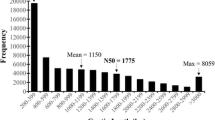Abstract
Grapefruit (Citrus pardisi) is a popular citrus fruit that is a cross between a sweet orange and pummelo. This research article focuses on an in silico approach for comparative analysis of C. paradisi green flavedo (GF) and ethylene treated flavedo (ETF) transcriptome data. Our pathway analysis provides comprehensive information of genes playing significant role in different stages of ripening in fruit. De novo assembly was carried out using six different assemblers namely GS assembler, SeqMan NGEN, Velvet/Oases, CLC, iAssembler and Cortex followed by subsequent meta-assembly, annotation and pathway analysis. We conclude that de novo transcriptome assembly using meta-assembly approach is used to increase assembly quality in comparison to single assembler.







Similar content being viewed by others
References
Barry Cornelius S, Giovannoni James J (2007) Ethylene and fruit ripening. J Plant Growth Regul 26:143–159
Jain M (2011) De novo assembly of chickpea transcriptome using short reads for gene discovery and marker identification. DNA Res 18(1):53–63
Moriya Y, Itoh M, Okuda S, Yoshizawa A, Kaneshia M (2007) KASS: an automatic genome annotation and pathway reconstruction server. Nucleic Acids Res 35:182–185
Zerbino DR, Birney E (2008) Velvet: algorithm for de novo short read assembly using de Bruijn graphs. Genome Res 18:821–829
Huang X, Madan A (1999) CAP3: a DNA sequence assembly program. Genome Res 9:868–877
Feldmeyer B, Wheat CW, Krezdorn N, Rotter B, Pfenninger M (2011) Short read Illumina data for the de novo assembly of a non-model snail species transcriptome (Radix balthica, Basommatophora, Pulmonata), and a comparison of assembler performance. BMC Genom 12:317
Kumar S, Blaxter ML (2010) Comparing de novo assemblers for 454 transcriptome data. BMC Genom 11:571
Altschul SF, Gish W, Miller W, Myres EW, Lipman DJ (1990) Basic local alignment search tool. J Mol Biol 215:403–410
Ribeiroa MHL, Rabaca M (2011) Cross-linked enzyme aggregates of naringinase: novel biocatalysts for naringin hydrolysis. Enzyme Res. 2011:851272
Conesa A, Gotz S, Garcia-Gomez JM, Terol J, Talon M, Robles M (2005) Blast2GO:a universal tool for annotation, visulization and analysis in functional genomics research. Bioinformatics 21:3674–3676
Wang XW, Liu SS (2010) De novo charecterization of a whitefly transcriptome and analysis of its gene expression during development. BMC Genom 11:400
Shi CY, Yang H, Wei CL (2011) Deep sequencing of the Camellia sinensis transcriptome revealed candidate genes for major metabolic pathways of tea-specific compounds. BMC Genom 12:131
Parani M (2011) De novo assembly and transcriptome analysis of five major tissue s of Jatropha curcus L. using GS FLX titanium platform of 454 pyrosequencing. BMC Genom 12:191
Kelebek H (2010) Sugars, organic acids, phenolic compositions and antioxidant activity of Grapefruit (Citrus paradisi) cultivars grown in Turkey. Ind Crops Prod 32(3):269–274
Huberman M, Zehavi U, Stein WD, Etxeberria E, Goren R (2005) In vitro sugar uptake by grapefruit (Citrus paradisi) juice-sac cells. Funct Plant Biol 32(4):357–366
Prasanna V, Prabha TN, Tharanathan RN (2007) Fruit ripening phenomena–an overview. Crit Rev Food Sci Nutr 47(1):1–19
Donascimento J, Júnior AV, Bassinello P, Cordenunsi B, Mainardi J, Purgatto E, Lajolo F (2006) Beta-amylase expression and starch degradation during banana ripening. Postharvest Biol Technol 40(1):41–47
Herrera M, Rodrigo J, Gil L (2007) Ethylene stimulates emission of terpenoids and aliphatic esters in citrus fruits. Adv Plant Ethyl Res 4:257–259
Terpenes, Terpenoids and Cannabis, http://berkeleypatientscare.com/2010/10/08/terpenes-terpenoids-and-cannabis/
Rodrigo MJ, Zacarias L (2007) Effect of postharvest ethylene treatment on carotenoid accumulation and the expression of carotenoid biosynthetic genes in the flavedo of orange(Citrus sinensis L. Osbeck) fruit. Postharvest Biol Technol 43:14–22
Lafuente MT, Sala JM (2002) Abscisic acid levels and the influence of ethylene, humidity and storage temperature on the incidence of postharvest rindstaning of ‘Navelina’ orange (Citrus sinensis L. Osbeck) fruit. Postharvest Biol Technol 25(1):49–57
Eo J, Lee BY (2009) Effects of ethylene, abscisic acid and auxin on fruit abscission in water dropwort (Oenanthe stolonifera DC.). Sci Hortic 123(2):224–227
Alós E, Cercós M, Rodrigo MJ, Zacarías L, Talón M (2006) Regulation of color break in citrus fruits. Changes in pigment profiling and gene expression induced by gibberellins and nitrate, two ripening retardants. J Agric Food Che 54(13):4888–4895
Brisker HE, Goldschmidt EE, Goren R (1976) Ethylene-induced Formation of ABA in Citrus Peel as Related to Chloroplast Transformations. Plant Physiol 58:377–379
Ogata YN (2006) Flavonoid composition of fruit tissues of citrus species. Biosci Biotechnol Biochem 70(1):178–192
Ness RW, Siol M, Barrett SCH (2011) De novo sequemce assembly and characterization of the floral transcriptome in cross- and self-fertilizing plants. BMC Genom 12:298
Mansell RL (1985) Naringin Levels in Citrus Tissues. Plant Physiol 77:903–908
Ververidis F, Trantas E, Douglas C, Vollmer G, Kretzschmar G, Panopoulos N (2007) Biotechnology of flavonoids and other phenylpropanoid-derived natural products. Part I: chemical diversity, impacts on plant biology and human health. Biotechnol J 2(10):1214–1234
Giorgio E, Parrinello N, Caccamese S, Rosini C (2004) Non-empirical assignment of the absolute configuration of (−)-naringenin, by coupling the exciton analysis of the circular dichroism spectrum and the ab initio calculation of the optical rotatory power. Org Biomol Chem 2:3602–3607
Menichinia F, Loizzoa MR, Bonesia M, Confortia F, Lucab DD, Stattia GA, Cindioc DE, Menichinia F, Tundis R (2011) Phytochemical profile, antioxidant, anti-inflammatory and hypoglycemic potential of hydroalcoholic extracts from Citrus medica L. cv Diamante flowers, leaves and fruits at two maturity stages. Food Chem Toxicol 49(7):1549–1555
Acknowledgments
We acknowledge UC-COE, for providing us transcriptome data of C. paradisi flavedo by mean of NCBI Sequence Read Archive. We also acknowledge Xcelris Labs Ltd. management for infrastructure and support.
Author information
Authors and Affiliations
Corresponding author
Rights and permissions
About this article
Cite this article
Patel, M., Manvar, T., Apurwa, S. et al. Comparative de novo transcriptome analysis and metabolic pathway studies of Citrus paradisi flavedo from naive stage to ripened stage. Mol Biol Rep 41, 3071–3080 (2014). https://doi.org/10.1007/s11033-014-3166-x
Received:
Accepted:
Published:
Issue Date:
DOI: https://doi.org/10.1007/s11033-014-3166-x




